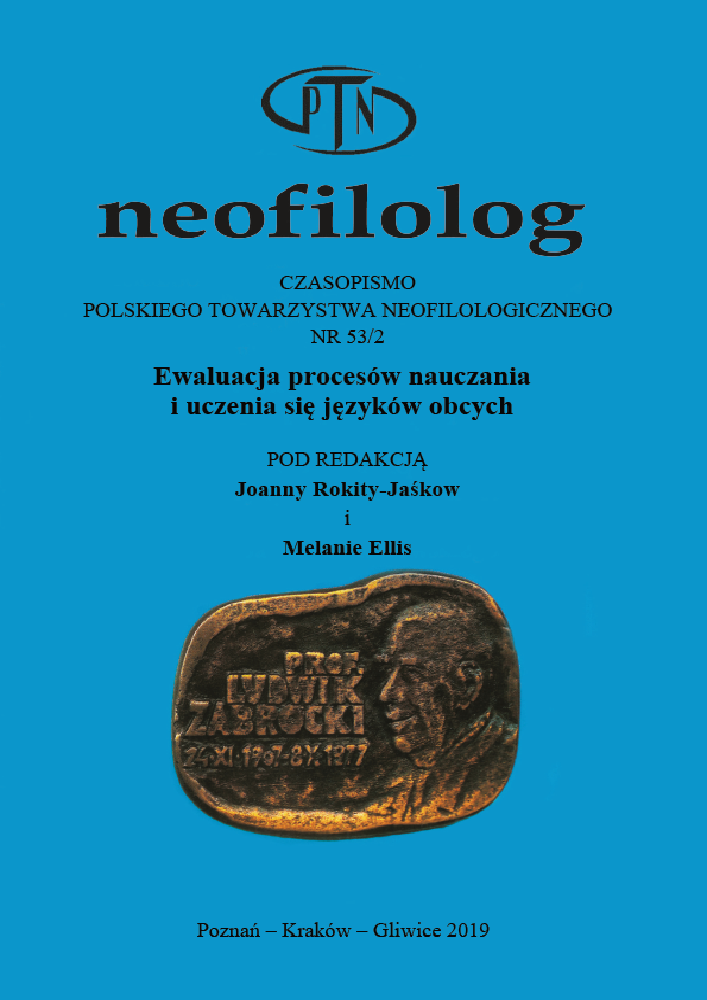Abstrakt
Writing is a complex skill since it requires the integration of various competences, which is a phenomenon extensively examined and discussed by researchers. However, the relation among these competences and their mutual influence, particularly at lower language proficiency levels (A1-A2/A2+), are analyzed more seldom. This issue constitutes the primary interest of our research. Carried out in the Institute of Romance Studies at Warsaw University, it focused on the following questions: how to adjust the evaluation method taking into account the above relation in order to facilitate the understanding of the complexity of the process of writing and to increase its effectiveness. The main study was preceded by a survey, conducted among all the students of the first year, who were beginners, concerning their perception of the difficulties of writing as well as their needs and expectations towards the writing class.
Bibliografia
Brown D. (2001), Teaching by principles: An interactive approach to language pedagogy. USA: Longman Pearson Education Company.
Barkaoui K. (2007), Teaching Writing to Second Language Learners: Insight from Theory and Research (w) „TESL Reporter”, nr 40, str. 35-48.
Chandler J. (2003), The efficacy of various kinds of error feedback for improvement in the accuracy and fluency of L2 student writing (w) „Journal of Second Language Writing”, nr 12, str. 267-296.
De Ketele J.-M. (2010), Ne pas se tromper d'évaluation (w) „Revue française de linguistique appliquée”, vol. XV, nr 1, str. 25-37. Online: https://www.cairn.info/revue-francaise-de-linguistique-appliquee-2010-1-page-25.htm [DW 02.08.2019].
De Ketele J.-M. (2013), L'évaluation de la production écrite (w) „Revue française de linguistique appliquée”, vol. XVIII, nr 1, str. 59-74. Online: ttps://www.cairn.info/revue-francaise-de-linguistique-appliquee-2013-1-page-59.htm [DW 02.08.2019].
Europejski system opisu kształcenia językowego: uczenie się, nauczanie, ocenianie. (2003). Warszawa: Wydawnictwo Centralnego Ośrodka Doskonalenia Nauczycieli.
Ferris D. R. (1999), The case for grammar correction in L2 writing classes: A response to Truscott (1996) (w) „Journal of Second Language Writing”, nr 8, str. 1-11.
Ferris D. R. (2004), The „Grammar Correction” Debate in L2 Writing: Where are we, and where do we go from here? (and what do we do in the meantime…?) (w) „Journal of Second Language Writing”, nr 13, str. 49-62.
Gérard F.-M. (2013), L'évaluation au service de la régulation des apprentissages: enjeux, nécessités et difficultés (w) „Revue française de linguistique appliquée”, vol. XVIII, nr 1, str. 75-92. Online: https://www.cairn.info/revue-francaise-de-linguistique-appliquee-2013-1-page-75.htm [DW02.08.2019].
Mashhadi F., Biria R. (2016), Error Is Not Terror: Error Correction in Second Language Writing (w) „Journal of Applied Linguistics and Language Research”, nr 3 (6), str. 199-212.Online: https://www.researchgate.net/publication/308874156_Error_Is_Not_Terror_Error_Correction_in_Second_Language_Writing [DW 02.08.2019].
Richards J.C., Renandya W. (2002),Methodology in Language Teaching: An Anthology of Current Practice. New York: Cambridge University Press.
Silva T., Matsuda P. K. (2002), Writing (w) Schmitt N. (red), An introduction to applied linguistics. Londyn: Arnold, str. 251-266.
Sowa M. (2015), Savoir-évaluer, czyli co i jak oceniać w języku obcym (w) „Języki Obce w Szkole”, nr 3. Online: http://jows.pl/artykuly/savoir-evaluer-czyli-co-i-jak-oceniac-wjezyku-obcym?page=show [DW 02.08.2019].
Truscott J. (1996), The case against grammar correction in L2 writing classes (w) „Language Learning”, nr 46 (2), str.327-369.
Vigner G. (2015), L’écrit et la langue : Quelles priorités ? Quelles articulations ? (w) „Études de linguistique appliquée, revue de didactologie des languescultures et de lexiculturologie”, nr 179, str. 269-275.
Licencja
Prawa autorskie (c) 2019 Agnieszka Dryjańska

Utwór dostępny jest na licencji Creative Commons Uznanie autorstwa – Bez utworów zależnych 4.0 Międzynarodowe.
Przedstawiany utwór (artykuł) upubliczniany jest na podstawie umowy z autorem i na licencji Creative Commons Attribution-NoDerivatives 4.0 International (CC BY-ND 4.0).
Użytkownicy mają obowiązek podania wraz z rozpowszechnionym utworem, informacji o autorstwie, tytule, źródle (odnośniki do oryginalnego utworu, DOI) oraz samej licencji;
- bez tworzenia utworów zależnych,
- utwór musi być zachowany w oryginalnej postaci.
Uniwersytet im. Adama Mickiewicza w Poznaniu zachowuje prawo do czasopisma jako całości (układ, forma graficzna, tytuł, projekt okładki, logo itp.).

